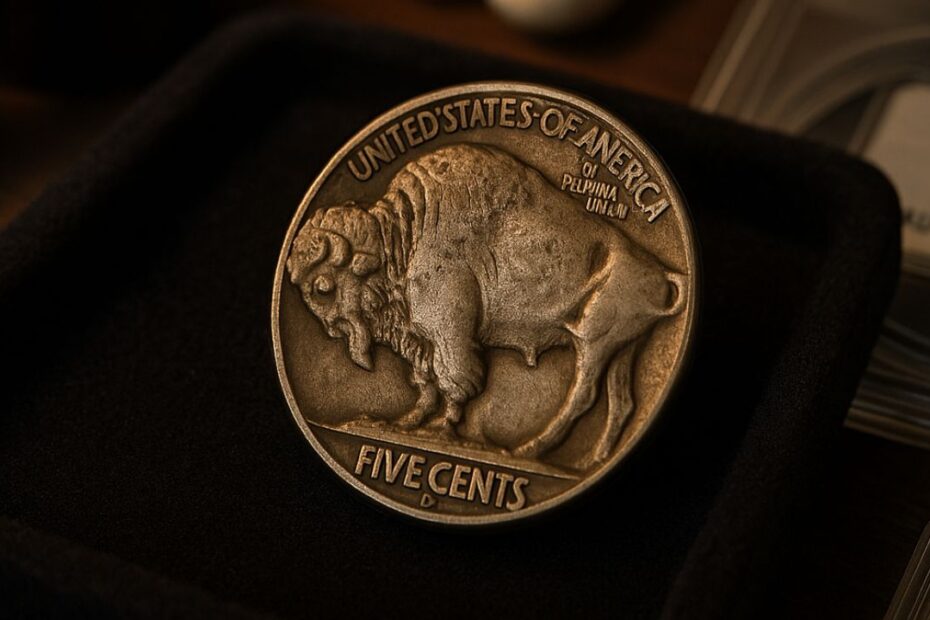If you’ve stumbled upon a coin labeled the 1937‑D Buffalo Nickel with what appears to be a “three-legged” bison on the reverse, you could be holding one of the most famous U.S. coin errors ever.
This article unpacks why the 1937-D Three-Legged Buffalo Nickel is so sought after, how much it’s worth today, and the authentication tips you must use to avoid counterfeits.
What Is the “Three-Legged” Buffalo Nickel?
The coin in question is a 5-cent piece struck at the United States Mint Denver facility in 1937 (mint mark “D”) as part of the Buffalo (or Indian Head) nickel series (1913–1938). The obvious oddity: the buffalo on the reverse appears to have only three legs.
That missing leg is not a design choice; it’s a minting error caused by over-polishing of the reverse die at Denver. One leg of the buffalo (the front-right foreleg) was effectively removed, leaving only the hoof and part of the shoulder.
Thousands of coins struck with that die were released before the error was caught — making this variety both authentic and collectible.
Why Collectors Care: Rarity, Legacy & Value
Over the decades, the three-legged variant has earned legendary status among numismatists. While the normal 1937-D Buffalo nickel has value, the error version carries a premium because:
- It stands out visually — the design oddity is obvious even to non-collectors.
- It’s rare in higher grades — many of the coins circulate, wear down, or get altered.
- It has strong historical significance — the error speaks to minting practices and die work of the era.
Value Chart: What the 1937-D “3-Legs” Nickel Is Worth Now
Here’s a snapshot of approximate values for this coin in various conditions (note: actual market prices vary):
| Condition (Grade) | Approximate Value |
|---|---|
| Fine (F-15) | ~$700 – $800 |
| Very Fine (VF-20) | ~$800 – $1,300 |
| About Uncirculated (AU) | ~$1,200 – $2,500 |
| Mint State (MS-65) | ~$25,000 + |
| Mint State (MS-66) | ~$50,000 + |
Lower-grade specimens are obtainable, but the big money comes when the coin is well-preserved, full-horn, strong strike and certified.
Authentication & What to Look For
Because the value is high, counterfeits and altered pieces exist. Use these authentication tips to increase your certainty:
- Check the Mint Mark: There should be a clear “D” mint mark under the words “FIVE CENTS”.
- Look for the Error: The buffalo’s front foreleg should be virtually missing — only the hoof shows. If you clearly see the full leg, it’s likely the normal variety.
- Examine Wear and Strike: Circulated coins will show wear; high-grade error coins should have strong detail, especially on the buffalo and the “3-leg” area.
- Certification Matters: Trusted grading houses (e.g., PCGS, NGC) with labels identifying the “Three-Legged” variety give much greater assurance and value.
- Beware Alterations: Some coins may have the leg removed or ground off to simulate the error. Look for unnatural polishing or tampering.
- Check Die Characteristics: Compare to published images and die varieties — the error was caused by a particular reverse die at Denver.
Why Its Value Keeps Climbing
- Scarcity in high grades: Many coins circulated heavily; finding one in near-mint state is rare.
- Collector demand: This variety enjoys a “legendary” status in error-coin collecting, boosting demand.
- Historic significance: The 1937-D three-leg error is well documented and widely known, making it easier to authenticate and market.
Key Facts at a Glance
| Feature | Detail |
|---|---|
| Coin Name | 1937-D Three-Legged Buffalo Nickel |
| Mint Mark | “D” (Denver) |
| Composition | 75 % copper / 25 % nickel |
| Diameter | ~21.2 mm |
| Weight | ~5 g |
| What Makes It Unique | Buffalo on reverse appears to have 3 legs |
| Primary Value Driver | Error variety + condition + certification |
| Typical Market Range | ~$700 to $50,000+ depending on grade |
The 1937-D Three-Legged Buffalo Nickel stands as one of the most iconic and collectible U.S. coin varieties.
While coins in average condition are attainable, the real worth lies in high-grade, well-certified examples — and even then, you must navigate authentication carefully. If you believe you have one, investing in grading and expert verification is essential.
Whether you’re a seasoned collector or just stumbled on a coin in a jar, this little nickel could be a hidden gem — but only if you treat it with the respect its pedigree demands.
FAQs
1. How can I tell if my 1937-D Buffalo Nickel is the “three-legged” variety?
Look at the buffalo’s front foreleg on the reverse. If the leg is virtually missing — just a hoof or partial shoulder visible — and the coin has the “D” mint mark, then it may be the genuine error variety.
2. Do all 1937-D Buffalo Nickels with three legs have the same value?
No. Condition (grade), certification, strike quality, luster and market demand all affect value. A heavily worn error coin might fetch a few thousand dollars, while a pristine MS-66 certified example could exceed $50,000.
3. Should I send my coin for grading?
Yes — if you believe it’s the three-leg variety and especially if you believe it’s in high condition. Professional grading by trusted services greatly increases marketability and value, and helps authenticate that rare variety.
